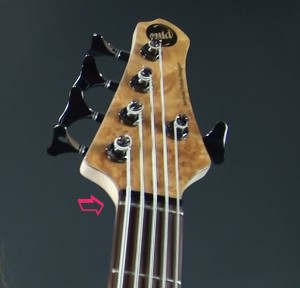
As of Friday I officially signed on to be an MTD endorser for their basses and strings. I bought my first MTD fretless bass a couple of months back and immediately fell in love with it. It’s quickly become my main bass. There are some aspects of the MTD that I’m surprised people don’t readily know about. Let’s take a look…
First off, the MTD Kingston Z bass has something called a “zero fret.”
And the zero fret could be the most ingenious thing I’ve ever seen on a guitar. Basically  what we have here is the nut has been pushed back a bit from the neck, allowing room for a fret in place of where the nut usually goes. The strings rest on this fret in the zero position. So basically, all your open strings have a fretted quality to them. This is especially advantageous to slap bass players since the open strings have a more solid sound to them.
what we have here is the nut has been pushed back a bit from the neck, allowing room for a fret in place of where the nut usually goes. The strings rest on this fret in the zero position. So basically, all your open strings have a fretted quality to them. This is especially advantageous to slap bass players since the open strings have a more solid sound to them.
Before I had the pleasure of a zero fret I would have to alter my hand position to avoid using open strings.
The nut is also in accordance to the Buzz Feiten tuning system, moving the strings a bit closer in scale reference to the rest of the bass. For more information on the Buzz Feiten tuning system and a diagram of the how MTD basses utilize it check out this link:
http://www.buzzfeiten.com/howitworks/howitworks.htm
The Buzz Feiten tuning system on the MTD basses corrects the tuning problems bass players run into when they start playing higher up on the neck. This unique nut set-up and bridge set-up essentially offsets certain pitches and brings the intonation closer to sounding correct to the human ear.
Typically when people set their intonation they move the string saddle to get the 12 fret harmonic and the 12 fret note to be at the zero position on the their tuner. And if you look at the bridge set up for most bass guitars you’ll see that the saddles are set further back for the lower strings and get increasingly closer to the neck as the strings increase to the higher strings. The Buzz Feiten tuning system’s bridge looks very different than this, tonally stealing certain pitches from different areas on the string to offset the tonal difference at higher ranges and making chords sound clearer and more pleasing to the ear.
Check out this video of Buzz Feiten explaining his system. He does a much better job than me.
http://www.youtube.com/watch?v=j2Yfee69bTk
So, for me, these two features alone was made me seek out the MTD bass and give it a shot. But it was the sound and feel that made me want to completely switch over.
And anyone that knows me as a player knows that I’m very picky about what kind of bass I want as my “main” instrument. Pickup position and volume knob position are a huge concern for me. I don’t want the neck pickup to be too close to the bridge because it won’t let me dig in the way I want when I slap and pop the string. I use volume swells a lot in my solo stuff so if the volume knob is too far away I won’t be able to swell the notes the way I want. If there’s too much play or if the knob is too stiff it’ll also affect the way I do my volume swells. The MTD has just the right settings in this department for me.
I look forward to my future relationship with MTD basses and strings.
Until next time…




